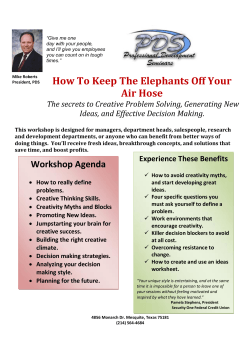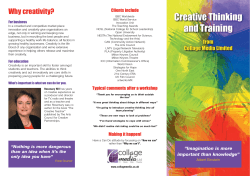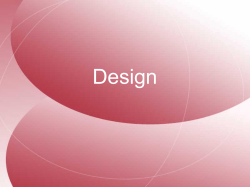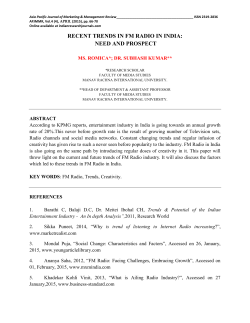
research perspectives of the innovation insights hub
RESEARCH PERSPECTIVES OF THE INNOVATION INSIGHTS HUB Monday, 16th March CSM/UAL London UAL's Community of Practice Initiative A-M Nisula, 2015 Anna-Maija Nisula Post-doctoral researcher, LUT School of Business and Management, Lappeenranta University of Technology, Finland Visiting reseracher, Innovation Insight HUB, Central Saint Martin/University of the Arts London UAL's Community of Practice Initiative A-M Nisula, 2015 Anna-Maija Nisula D.Sc. (econ & bus.adm), M.Sc. (tech) Post-doctoral researcher and project manager at the LUT School of Business and Management at Lappeenranta University of Technology. My research focus is on knowledge management, and more specifically on the development of organizational renewal capability, organizational creativity, individual and team creativity, innovative behavior, temporary and new forms of organizing, agile co-creation practices, radical innovation. My PhD research examined the development of organizational creativity as a multi-level phenomenon from multi-theory perspective, including an approach based on improvisational theatre. Visiting researcher at Innovation Insights HUB at the University of the Arts London/CRM Research project experience INNOSPRING CATCH (2015-2016) Captruing opporturnities and co-creating value in the digital economy (ongoing), *) AGILE (2014-2015) Agile co-creation practices for business development (ongoing) *) INWORK (2012-2013). Measuring and mangaing the workplace innovation. *) WORK-IN-NET (2009-2011). Development of organizational renewal capability, *) INNOSPRING ACCESS: (2005-2006) Collaborative Innovation and Networked R&D. *) *) Researcher and project manager A-M Nisula, 2015 my research perspectives 1. creativity and innovative behaviour - indivudual/employee improvisation in organization - innovative creative behaviours in co-creation 2. improvisation and improvisationl theatre - dynamic innovative behavior (improvisation) - collective creativity and improvisation - improvisation in enhancing creativity in team/organization 3. new forms of organizing - temporary groups, short innovation events, self-organizing (nonhierachical groups), crowds (crowdsourcing), virtual co-creation A-M Nisula, 2015 CREATIVE PARTNERSHIP | collaboration | co-creation | co-desing | creative synthesis | | co-improvisation | A-M Nisula, 2015 CREATIVE PARTNERSHIP | designer | producer | user | customer | A-M Nisula, 2015 MOTIVATION FOR PARTNERSHIP | novel outcome | business | learning | fun | passion | - to create new by combining knowledge, creativity, compentences, perspectives and interpretations of the partners in a novel and situational manner A-M Nisula, 2015 CREATIVE PARTNERSHIP relationship | way create | practices - creative partnership is built/invented by the partners - developing and open emerging for directions - practices are re-shaped - grounded by mutual trust and engagement - shared goal - benefits (gives value) all partners A-M Nisula, 2015 How the expertise, creativity, engagement, perspectives and interpretations of the partners can be synthetized in a creative manner? A-M Nisula, 2015 The nature of creative parntership Creative partnership is improvisational … - “unplanned” – built in interaction between the partners - designing and producing simultaneously (making experiments) - unexpected turning points are likely - result is open-ended – shaped by the partners - each partner has equal possibility to contribute on the creation - partners assume shared responsibility (Sawyer and DeZutter, 2009; Prins, 2008) A-M Nisula, 2015 …from improvisational theatre into organization collective improvisation is group’s or community’s social ability (Nonanaka and Toyoma, 2007; Erden et al. 2008), it represent the highest level of group’s tacit knowledge (Erden et al., 2008). Partnerships, groups, communities, organizations constitute of interplaying and interdependent individuals A-M Nisula, 2015 Individual behaviors that build creative partnership - accept ideas coming from others and build on them - trust - be alert to the opportunities presented by the situation and help to move the action forward - take the lead (and give lead) at different times depending on the needs of the situation. - consider errors as a source of ideas (or novel directions) - be open for initiatives and contributions of the others (Vera & Crossan, 2005; Johnstone, 1989; Koppett, 2001) A-M Nisula, 2015 Conclusions co-creation, co-design and other multiparty collaborations are increasingly common such co-creation resembles collective improvisation actors who can build partnerships in novel combinations of expertise, knowledge, competence, creativity, are likely to achieve novel outcomes and simultaneously learning (for the future) improvisational theatre provides techniques and tools for stimulating co-creation, and collective behaviors in various contexts A-M Nisula, 2015 Thank you! anna-maija.nisula@lut.fi a.nisula@arts.ac.uk twitter @NisulaAm LinedIn UAL's Community of Practice Initiative A-M Nisula, 2015
© Copyright 2025











